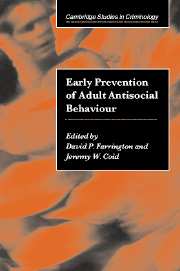Book contents
- Frontmatter
- Contents
- List of figures
- List of tables
- List of contributors
- Preface
- 1 Advancing knowledge about the early prevention of adult antisocial behaviour
- 2 Formulating strategies for the primary prevention of adult antisocial behaviour: “High risk” or ‘population’ strategies?
- 3 Risk factors for adult antisocial personality
- 4 Preventing the intergenerational continuity of antisocial behaviour: Implications of partner violence
- 5 Protective factors and resilience
- 6 Prevention during pregnancy, infancy and the preschool years
- 7 Prevention through family and parenting programmes
- 8 Prevention in the school years
- 9 Prevention of antisocial behaviour in females
- 10 Economic costs and benefits of primary prevention of delinquency and later offending: A review of the research
- 11 Conclusions and the way forward
- Index
- References
3 - Risk factors for adult antisocial personality
Published online by Cambridge University Press: 22 September 2009
- Frontmatter
- Contents
- List of figures
- List of tables
- List of contributors
- Preface
- 1 Advancing knowledge about the early prevention of adult antisocial behaviour
- 2 Formulating strategies for the primary prevention of adult antisocial behaviour: “High risk” or ‘population’ strategies?
- 3 Risk factors for adult antisocial personality
- 4 Preventing the intergenerational continuity of antisocial behaviour: Implications of partner violence
- 5 Protective factors and resilience
- 6 Prevention during pregnancy, infancy and the preschool years
- 7 Prevention through family and parenting programmes
- 8 Prevention in the school years
- 9 Prevention of antisocial behaviour in females
- 10 Economic costs and benefits of primary prevention of delinquency and later offending: A review of the research
- 11 Conclusions and the way forward
- Index
- References
Summary
Antisocial personality is a serious disorder of adulthood that is highly refractory to treatment. Indeed, its prognosis is so poor that the most viable strategy may be to focus on the eventual development of preventive interventions. Because antisocial personality clearly arises from childhood conduct problems (Robins, 1966), researchers have long sought to specify the characteristics of those children who will later develop antisocial personality. When this is accomplished, the etiology of antisocial personality can be studied at the time of its earliest emergence and preventive interventions can be developed. Currently however, there are serious gaps in our knowledge about the childhood origins of antisocial personality.
There are several diagnoses that have been implicated in the development of Antisocial Personality Disorder (APD) (or ASPD sometimes) (American Psychiatric Association, 1994), including Conduct Disorder (CD), Oppositional Defiant Disorder (ODD), and Attention Deficit-Hyperactivity Disorder (ADHD). The essential features of CD are a repetitive and persistent pattern of behaviour in which the basic rights of others and major age-appropriate societal norms or rules are violated. ODD is a recurrent pattern of negativistic, defiant, disobedient, and hostile behaviour toward authority figures, which leads to impairment. The most important features of ADHD are overactivity, impulsivity, and attention problems at levels atypical for a child's age.
Although most evidence suggests that CD always precedes Antisocial Personality Disorder (American Psychiatric Association, 1994), some evidence suggests that antisocial personality often arises in individuals with a history of Attention-Deficit Hyperactivity Disorder (ADHD) during childhood, instead of CD.
- Type
- Chapter
- Information
- Early Prevention of Adult Antisocial Behaviour , pp. 79 - 108Publisher: Cambridge University PressPrint publication year: 2003
References
- 18
- Cited by

